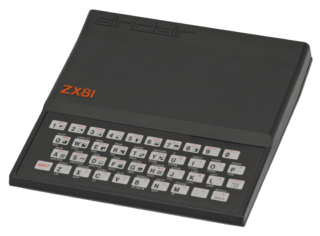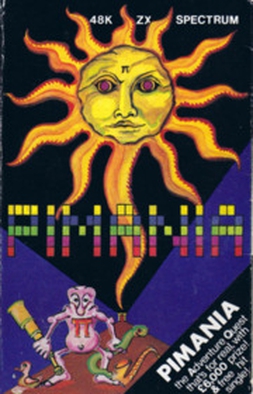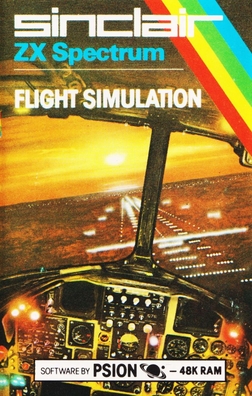
The ZX Spectrum is an 8-bit home computer developed and marketed by Sinclair Research. Considered one of the most influential computers ever made, it is also one of the best-selling British computers ever, with over five million units sold. It was released in the United Kingdom on 23 April 1982, and around the world in the following years, most notably in Europe, the United States, and Eastern Bloc countries.

The ZX81 is a home computer that was produced by Sinclair Research and manufactured in Dundee, Scotland, by Timex Corporation. It was launched in the United Kingdom in March 1981 as the successor to Sinclair's ZX80 and designed to be a low-cost introduction to home computing for the general public. It was hugely successful; more than 1.5 million units were sold. In the United States it was initially sold as the ZX-81 under licence by Timex. Timex later produced its own versions of the ZX81: the Timex Sinclair 1000 and Timex Sinclair 1500. Unauthorized ZX81 clones were produced in several countries.
Sinclair BASIC is a dialect of the programming language BASIC used in the 8-bit home computers from Sinclair Research, Timex Sinclair and Amstrad. The Sinclair BASIC interpreter was written by Nine Tiles Networks Ltd.

3D Monster Maze is a survival horror video game developed from an idea by J.K. Greye and programmed by Malcolm Evans and released in 1981 for the ZX81 with the 16 KB memory expansion. The game was initially released by J. K. Greye Software in December 1981 and re-released in 1982 by Evans' own startup, New Generation Software. Rendered using low-resolution character block "graphics", it was one of the first 3D games for a home computer, and one of the first games incorporating typical elements of the genre that would later be termed survival horror.

Christopher Mark Sievey was an English musician, comedian and artist known for fronting the band the Freshies in the late 1970s and early 1980s and for his comic persona Frank Sidebottom from 1984 onwards.
Vortex Software was a video game developer founded by Costa Panayi and Paul Canter in the early 1980s to sell the game Cosmos which Panayi had developed for the Sinclair ZX81. They converted the game to the ZX Spectrum, but due to the low sales of the ZX81 version they licensed the game to Abbex.

Pimania is a text-and-graphics adventure game written by Mel Croucher and released by Automata UK in 1982 for the BBC Micro, ZX Spectrum, Dragon 32, and ZX81. It was the first real-life video game treasure hunt to be released. It was inspired by the 1979 Kit Williams book Masquerade. Automata gave a prize of a golden sundial worth £6,000 for the first person to solve the various cryptic clues to its location that were hidden within Pimania.

Artic Computing was a software development company based in Brandesburton, England from 1980 to 1986. The company's first games were for the Sinclair ZX81 home computer, but they expanded and were also responsible for various ZX Spectrum, Commodore 64, BBC Micro, Acorn Electron and Amstrad CPC computer games. The company was set up by Richard Turner and Chris Thornton. Charles Cecil, who later founded Revolution Software, joined the company shortly after it was founded, writing Adventures B through D. Developer Jon Ritman produced a number of ZX81 and Spectrum games for Artic before moving to Ocean Software.
J.K. Greye Software was a British software company set up by J.K. Greye in early 1981 and 6 months later joined by Malcolm Evans after they met at a Bath Classical Guitar & Lute Society meeting in Bath in 1981. They produced computer games for the ZX81 and ZX Spectrum home computers.
The Freshies are an English punk rock band, formed in Manchester in 1978. The band was founded by singer-songwriter and comedian Chris Sievey, whose best-known creation – comedy character Frank Sidebottom – originated as a mascot for the group.
Crystal Computing, later renamed Design Design, was a British video game developer founded in 1982 by Chris Clarke and Ian Stamp while students at the University of Manchester. Graham Stafford, Neil Mottershead, Simon Brattel and Martin Horsley, joined the company as it expanded. The company's first software release was a compilation of games for the Sinclair ZX81, though it was with the ZX Spectrum that Crystal found its greatest success. A deal with the machine's manufacturer Sinclair to distribute Crystal's Zeus Assembler gave the company sufficient funds for a major marketing campaign for their next product, Halls of the Things, an arcade adventure game that became their most successful title.
The ZX Spectrum's software library was very diverse. While the majority of the software produced for the system was video games, others included programming language implementations, Sinclair BASIC extensions, databases, word processors, spread sheets, drawing and painting tools, and 3D modelling tools.

Mike Singleton was an influential British video game designer who wrote a number of well-regarded titles in the 1980s, as well as being a contributor to games in the 21st century. His titles include The Lords of Midnight, Doomdark's Revenge, Dark Sceptre, War in Middle Earth and Midwinter. Before developing video games, Singleton was an English teacher in Ellesmere Port, Cheshire, England.

The Sinclair ZX Printer is a spark printer which was produced by Sinclair Research for its ZX81 home computer. It was launched in 1981, with a recommended retail price of £49.95.

The Biz is a management simulation game published by Virgin Games for the ZX Spectrum in 1984. In The Biz, the player manages a rock band. The price of the game on release was £6.95, which is equivalent to £28.22 today. The tape cassette contained the program, an interview with Frank Sidebottom and Chris Sievey, and eight singles.
Richard Francis Altwasser is a British engineer and inventor, responsible for the hardware design of the ZX Spectrum.

Flight Simulation is a flight simulation program written by Psion and marketed by Sinclair Research for the ZX Spectrum and ZX81 home computers.

The Thompson Twins Adventure is a 1984 graphic adventure game that was distributed by Computer and Video Games magazine as a promotional 7" flexi disc "freebie" along with its October 1984 issue. The game is based on the Thompson Twins' single "Doctor! Doctor!", and features the Thompson Twins band members as the protagonists. The unusual storage format of the game showcases an experimental technique pioneered by the London-based Flexi Records label, and places the game alongside a small handful of other games distributed on grooved disks. This format never became established and The Thompson Twins Adventure is today valued more for its nostalgic and artifactual value than for its ludological aspects which have been uniformly panned by critics.
Vinyl data is the use of vinyl discs to store sequenced/encoded data rather than for simple analog recordings. This alternate use of the storage medium enabled the code of full motion videos (FMVs) and even simple video games to be stored in an analog format along with the soundtrack and sound effects. These vinyl data discs took two forms: the FMV-only Capacitance Electronic Disc (CED), and the program sheet. Uncommon even in the early 1980s when the practice was at its height, program sheet game data required that users record from the disc onto an audio cassette tape which could then be used via the cassette port with microcomputers such as the BBC Micro, Commodore 64, Commodore PET, VIC-20, Dragon 32/64, ZX81, or ZX Spectrum. The use of CEDs to store video game FMV data was even less common, and required the game console to select a section of the grooved track to read with its stylus at just the right time for the video to be displayed. The numerous limitations of these techniques contributed to their failure to receive widespread acceptance and video game data stored in this manner remains some of the most difficult to archive and preserve.











